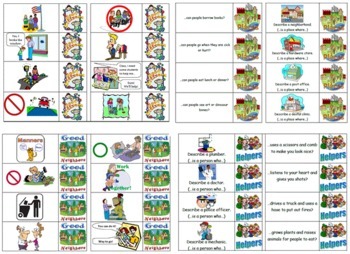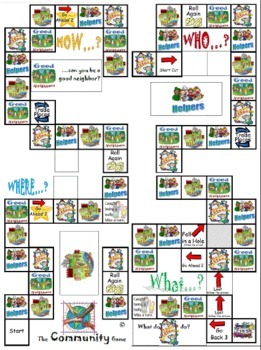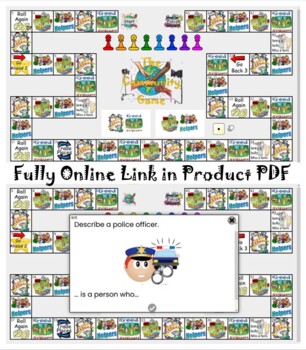Community and Values of Citizenship Printable and Digital Board Game
- PDF
Description
*NEW for 2021 - Fully Online Version of the Community Board Game in addition to the original printable, great for projectors, smartboards, online teaching, etc. and saves a ton of paper, ink and time! Easy game play via Flippity web host! Link inside the product.
The beginning of the year is a great time to introduce kids to the foundations of good citizenship and neighborly values with this set of resources designed either as a stand-alone unit on citizenship or as an add-on to a larger unit on the standard community topics of workers and places. It features 32 large flashcards (16 each for citizenship and good neighbors), sets of smaller matching cards with picture on one and words on another for memory or go fish games, and a cumulative board game featuring all of the same logos as the flashcards along with workers and places topics added in. I have recently also added two 10-page read-aloud books introducing the citizenship and good neighbor topics, which are printable or projectable and look great on a smartboard or projector, as well as a blank-fill exercise with characteristics of good citizens and a printable reading response book with blank lines and clip art for kids to customize their own Good Citizens book.
This set and board game are designed to review the essential community topics of helpers and places, while also introducing and incorporating a major focus on community values, or concepts of citizenship. The four panels of the board game can be printed on four sheets of regular-sized paper, and then pasted together to form a continuous path. With the “Start” square in the lower left and the “Finish” square in the lower right, the other paths should match up when placed correctly. Permission for use of the original template for this board game was graciously granted by Chris Gunn of Bogglesworldesl.com. Thanks so much!
The cards are formatted so that you can fold over the category name on the dotted line, paste it to the front of the card, and ideally laminate both the game board and card sets to promote longer life. The game board has rectangular spots showing the category logo, on which to set each of the card category sets. There are 16 cards each for the Neighbors and Citizens categories, and 18 each of the Helpers and Places categories.
Students are to place any simple colored tokens on the start square, then roll a die and move that number of squares. When they land on a square with a category logo, they are to take a card from that category and answer or say what the card indicates.
The “Helpers” and “Places” cards each have two varieties. One type is a question card, for which the player uses the designated question word for that category (‘Who…’ or ‘Where…’) and reads the rest of the question contained on the card, then attempts to answer in a full sentence. The other type are “Describe” cards, which ask the player to describe a person or place in a full sentence. Usually, I will make the condition that the players must tell two or three distinct things about the person or place, using the sentence starter on the card, for example, “(A barber) is a person who cuts hair and uses a scissors and comb.”
The neighbors and citizens cards also have a designated question word which is printed on that part of the board near the card spot. When a player lands on one of those logos, the other players are allowed to ask as a group, “How can you be a good neighbor?” or, “What do good citizens do?” The player with the card then has to make a sentence answering that question using the picture prompt on the card they picked. Suggested phrases are the ones featured on the large flashcard versions of each of the neighbor and citizen cards, which are included in the last third of the file for teaching these concepts before playing the game. There are 16 flashcards for each category, just like the small game cards.
The community helpers featured in the game are the same ones featured in my 'Community Helpers' mini-book riddles set, and I'm working on a complementary set for places as well. Of course, there are a multitude of resources for teaching community helpers and places, but I have found that there are comparitively few for teaching the community values of citizenship which I've included here. The series I used to introduce these in read-aloud was the Powerkids Press "I Am an American Citizen" series, which has 6 titles for various topics of citizenship.
There are other kinds of squares in the game as well which are pretty self-explanatory. “Caught being a bully/Miss a turn” squares mean that the player must stay there for an extra go-round of the other players without rolling or moving. The “Trade Places” squares mean that the player can choose any of the other players to trade places with, anywhere on the board. This can be controversial, but also fun, so use your own judgement as to whether it is appropriate for your students. Finally, the winner is the student (or team) that is able to reach the finish, or is closest to the finish when the game ends.
The topics included in the game support foundational K-2 social studies standards of many of the Common Core states as well as Texas. For example, from the Essential Standards of my own state, North Carolina, the Civics and Government strand of the kindergarten social studies standards K.C & G.1, the Essential Standard is, “Understand the Roles of a Citizen,” and the clarifying objectives for the standard are, 1.1, “Exemplify positive relationships through fair play and friendship,” and 1.2, “Explain why citizens obey rules in the classroom, school, home and neighborhood.” In addition, the basic concepts of economic and financial literacy are also supported, for example, from the Grade 1 Economics Strand, 1.E.1.1, “Summarize the various ways in which people earn and use money for goods and services,” and 1.E.1.2, “Identify examples of goods and services in the home, school and community.
For just one more example, the Texas Essential Knowledge and Skills (TEKS) recognize the importance of “the study of the self, home, family, classroom and community to establishing the foundation for responsible citizenship in society.” (§113.12. Social Studies, Grade 1) To this end, in kindergarten, for example, (7) Economics. The student understands the value of jobs. The student is expected to: (A) identify jobs in the home, school, and community; and(B) explain why people have jobs. And later in Grade 1, (13) Citizenship. The student understands characteristics of good citizenship as exemplified by historical figures and other individuals. The student is expected to: (A) identify characteristics of good citizenship, including truthfulness, justice, equality, respect for oneself and others, responsibility in daily life, and participation in government by educating oneself about the issues, respectfully holding public officials to their word, and voting.
A note on the preview file: the images are gif. captures, and not full size or resolution. As indicated above, the gameboard is four full-size (A4) pages pasted together, the large flashcards are two to a page, and the game category cards are 8 to a page.
I hope that this resource serves you well. Please leave comments for me if you think I can improve on the design in any way. I appreciate your viewing this product, and thank you whole-heartedly if you do decide to purchase.





